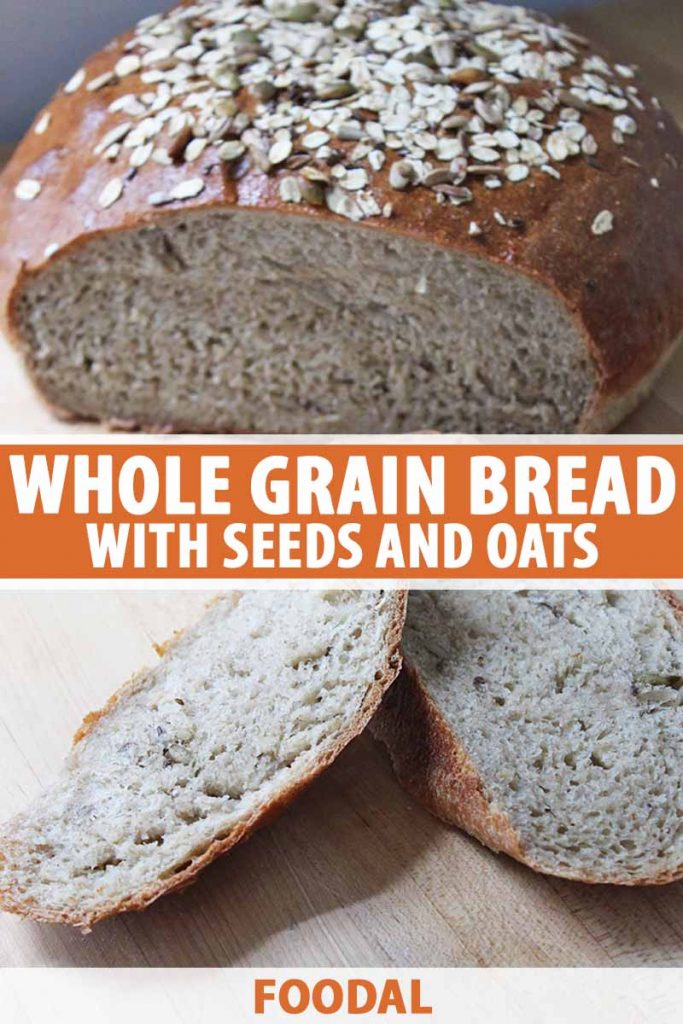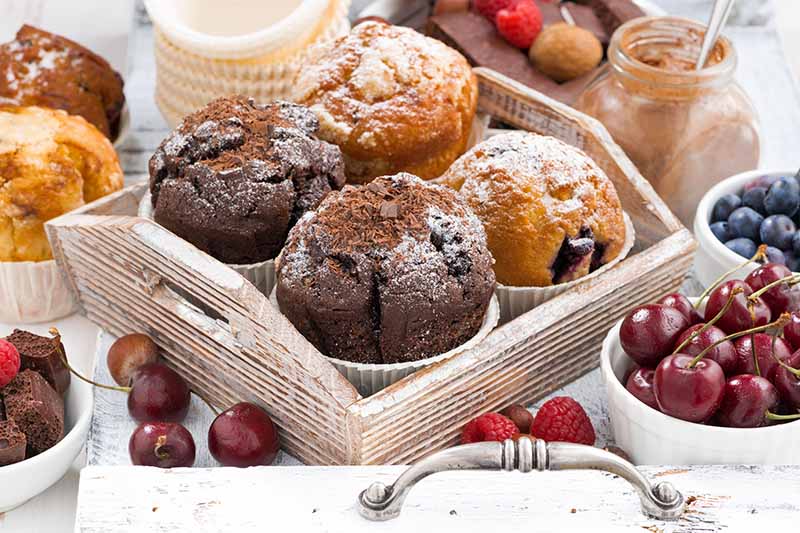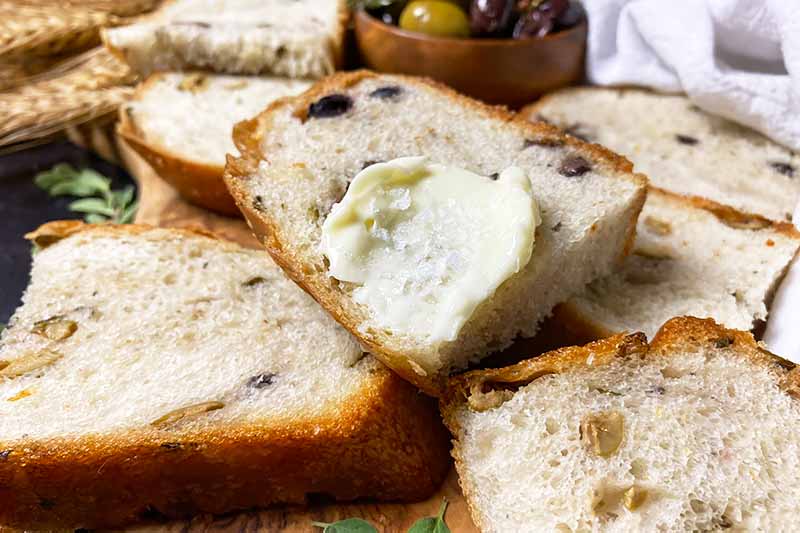Ready to start baking with whole grains? Making this homemade multigrain bread needs to be at the top of your to-do list!
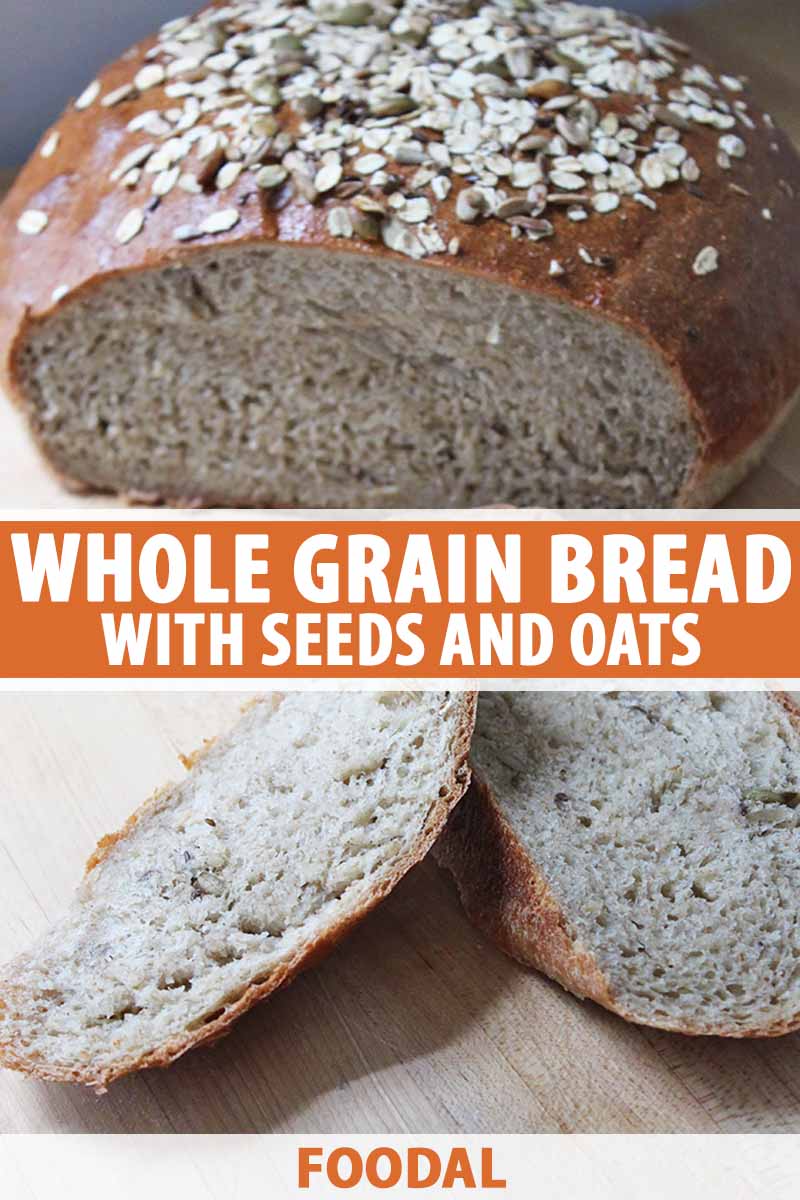
If you want to incorporate more whole grain goodness into your diet, and you also want to gain more at-home baking experience, making your own bread completely from scratch will satisfy both cravings.
In this recipe, we’ve applied many tips outlined in our comprehensive tutorial for baking with whole grains to create a hearty and delicious multigrain loaf.
The yeasted base includes three different types of flour – spelt, white whole wheat, and bread flour – in order to develop the best gluten network and yield a perfectly sliceable bread you can use for so many different applications.
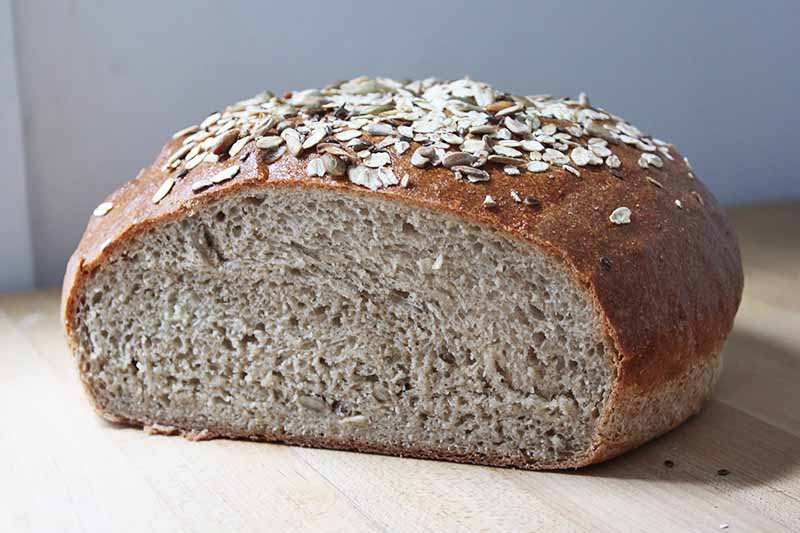
We also fold in some flax, pumpkin, and sunflower seeds to give the loaf even more flavor, texture, and nutrition.
And the topping that coats the outside of the bread – a mix of rolled oats and more seeds – is a beautiful final touch that brings even more texture with every slice.
You’ll be amazed that something so healthy can still be so light and fluffy, and fun to eat!
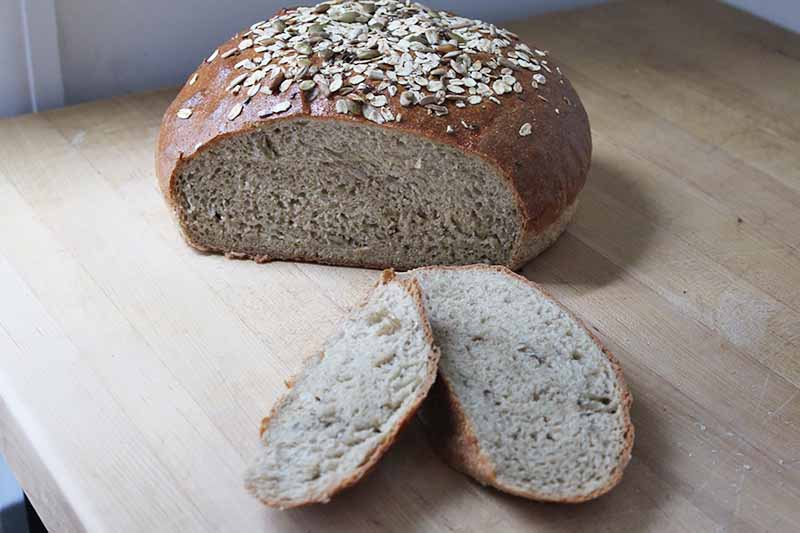
Be sure to review our Cooking by the Numbers guide after the recipe for a more thorough breakdown of each step. We have tips and tricks to share with you, bread bakers!
And don’t stop there – check out the conclusion at the very end of this article to discover all the fun ways you can use each homemade loaf – and we mean the entire loaf, ends and all – throughout the whole day for breakfast, lunch, dinner, and dessert.
Print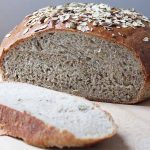
Whole Grain Bread with Seeds and Oats
- Total Time: 3 hours, 10 minutes
- Yield: 1 10-inch loaf (about 10 slices) 1x
Description
You don’t have to buy a loaf of whole grain bread at the store when you can make our light and fluffy version with oats and seeds right at home.
Ingredients
- 1 cup spelt flour
- 1 cup white whole wheat flour
- 2 cups bread flour
- 2 tablespoons granulated sugar
- 2 teaspoons coarse kosher salt
- 1 tablespoon instant dry yeast
- 2 cups warm water, around 100°F
- 1 tablespoon raw sunflower seeds, divided
- 1 tablespoon raw pumpkin seeds, divided
- 1 tablespoon flax seeds, divided
- Olive or vegetable oil, for greasing
- 1 large egg, beaten lightly
- 1 tablespoon rolled oats
Instructions
- Whisk together all the flours with the sugar, salt, and yeast in a large bowl.
- Form a small well in the center of the dry ingredients and pour in the water. Using a pliable bowl scraper or clean hands, pull the flour mixture into the water and slowly work the ingredients together. Once the water is incorporated and the flour has formed a shaggy dough, turn it out onto a clean counter.
- Cover the dough with a clean, damp kitchen towel. Let the dough rest for 15 minutes to soften the bran and germ.
- Remove the towel and knead the dough by hand for 8-10 minutes. Add half of the sunflower, pumpkin, and flax seeds, and knead for an additional 2-5 minutes, until the dough forms a smooth ball and you can perform a successful windowpane test.
- Place the dough in a large, lightly oiled bowl. Cover with a damp towel. Allow to rest at room temperature for an hour, or until doubled in size.
- Remove the dough from the bowl and place on a clean counter. Shape into a large round and place in the center of a rimmed half-size baking sheet lined with parchment paper or a silicone mat.
- Cover with a damp kitchen towel and let proof at room temperature for about an hour, or until you can touch the top lightly and it springs slowly back into place.
- Preheat the oven to 375°F. Combine the remaining seeds with the oats in a small bowl.
- Remove the towel and lightly brush the outside of the dough with the whisked egg. Sprinkle the seed and oat mix on top.
- Transfer to the oven and bake for 25 minutes, or until the inside of the bread reaches 180°F.
- Remove from the oven and let cool for 10 minutes on the baking sheet before transferring to a cooling rack to cool completely.
- Prep Time: 30 minutes
- Cook Time: 25 minutes
- Category: Bread
- Method: Baking
- Cuisine: Baked Goods
Keywords: whole wheat, whole grain, bread, oats, seeds
Cooking by the Numbers…
Step 1 – Prep and Combine Dry Ingredients
Measure out all of your ingredients, but wait to break and whisk the egg in a later step.
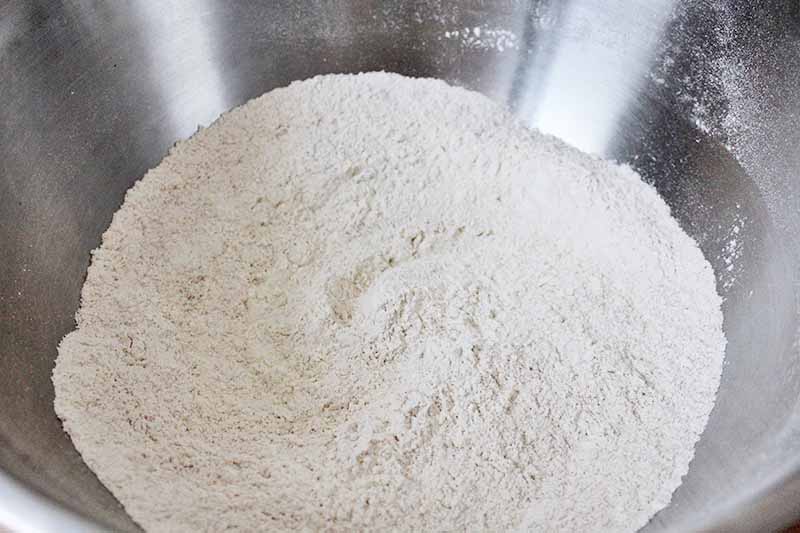
Line a half-size rimmed baking sheet with a silicone mat or parchment paper and set aside.
Use a thermometer to check the temperature of your water.
Combine all of your dry ingredients – the spelt, white whole wheat, and bread flours, sugar, salt, and instant yeast.
This can be done in a large mixing bowl with a whisk to keep your ingredients contained, or on a large, clean countertop if you prefer to mix by hand.
Step 2 – Add Water and Form Dough
Form a well in the center of the dry mixture, and add the warm water.
With your hands or a bowl scraper, form the dough by gradually pulling the flour into the water at the center of the well. Once you’ve formed a shaggy dough, turn it out onto a floured countertop if it’s not there already.
Let the mound rest for about 15 minutes. This will help to soften those hearty whole grains, which will improve both the texture and digestibility of the bread.
Step 3 – Knead and Add Seeds
Knead the dough for 8 to 10 minutes.
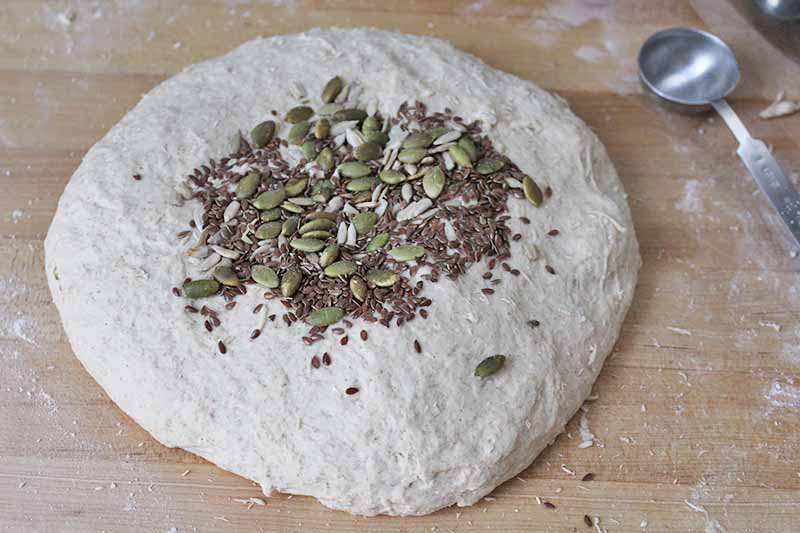
Add half of the raw sunflower, raw pumpkin, and flax seeds – this will be half a tablespoon for each type of seed. Set aside the remaining seeds for the final topping.
Continue to knead until a smooth ball forms, for about 2 to 5 minutes.
Perform the windowpane test to check to see if the gluten structure has developed enough. This involves pulling a small piece of dough in opposite directions between your fingers to see if it is able to thinly stretch without immediately ripping.

If it doesn’t pass the windowpane test, continue kneading the dough for another 2 to 5 minutes and retest. Repeat as necessary.
Step 4 – Rise, Shape, and Proof
Coat a large mixing bowl with olive or vegetable oil.

Form the dough into a smooth, tight ball and place in the bowl with the seam facing the bottom. Cover with a clean and slightly damp kitchen towel, and set aside to rise at room temperature for about an hour.
Turn out the dough onto a clean counter and shape into a round ball. Transfer it to the prepared baking sheet. Cover with a slightly damp towel and allow to proof at room temperature.
You’ll know it’s ready when the dough springs back after being gently pressed with your finger.
Step 5 – Add Toppings and Bake
When the round is nearly done proofing, preheat the oven to 375°F.
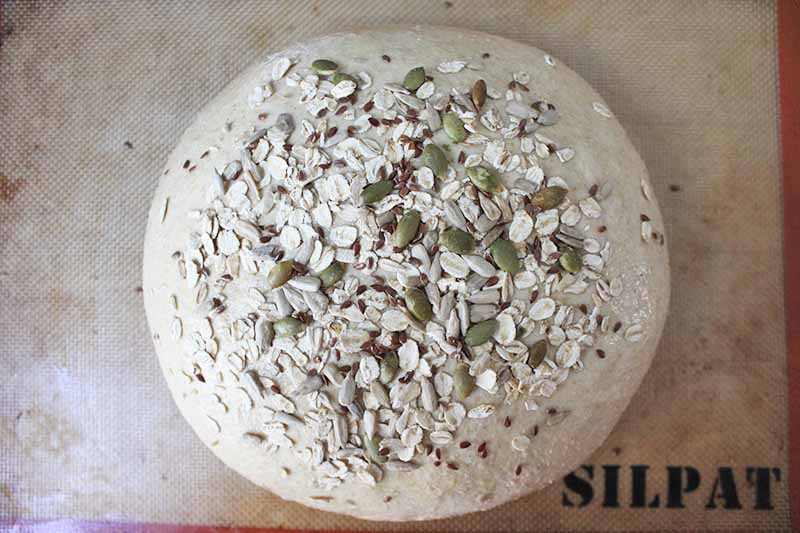
Lightly beat the egg in a small bowl, and thinly brush it on the exposed top and sides of your loaf. A pastry brush makes this process very quick and easy.
Combine the remaining seeds with the oats in a small bowl. Evenly sprinkle this mix on top of the dough. The egg wash will help the seeds and oats to stick.
Capture and reposition any escapees that make their way onto the baking sheet!
Transfer the baking sheet to the oven and bake for about 25 minutes, or until the loaf is brown and firm on the outside.
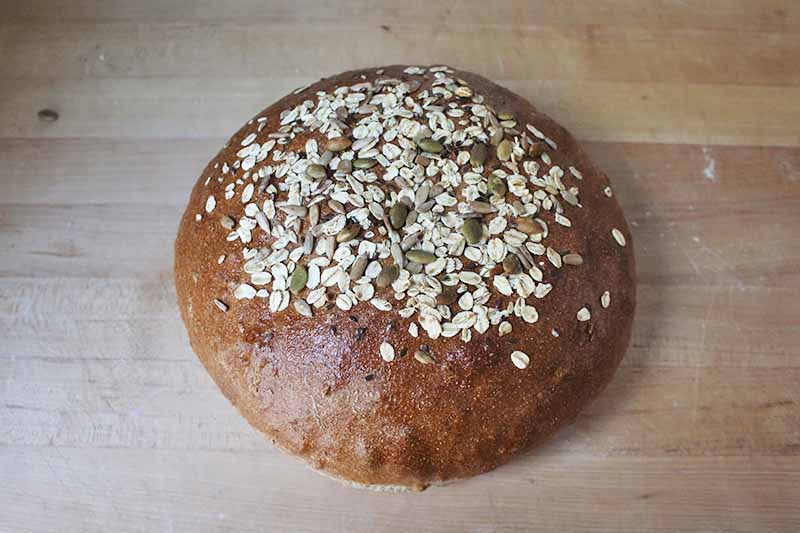
If you want to check the internal temperature of your loaf with a thermometer, it should be at about 180°F when it’s done.
Remove the baking sheet from the oven. Let the loaf cool briefly on the baking sheet for 10 minutes before transferring it to a cooling rack to cool completely. You can also serve the bread while it’s still slightly warm.
Slice with your favorite serrated bread knife and enjoy!
Make Every Slice Count
As promised, we have so many fun ideas for you to enjoy every bite of this fluffy whole grain bread!

Starting with breakfast, make savory breakfast toasts by layering toasted slices with crispy bacon, thick slices of ripe tomatoes, perfectly cooked fried eggs, and a few turns of freshly cracked black pepper.
For lunch and dinner, you have endless opportunities for crafting the best and heartiest sandwiches! Use this bread to make recipes like sprouts, avocado, and cheddar sandwiches, peach basil grilled cheese, or curried chicken salad sandwiches. It also makes a delicious accompaniment to a bowlful of homemade soup.
And for dessert? Make our homemade bread pudding with fruit and nuts and serve it warm alongside freshly whipped cream or your favorite ice cream.
How will you use every slice of this whole grain bread? We love new ideas! Send us a comment below.
Leave your oven on, because we still have more baking to do! For more honest-to-goodness recipes featuring whole wheat, you’ll love these healthful and homemade delights:
- Sprouted Wheat Coconut Cocoa Banana Muffins
- Kefir-Soaked Spelt Pizza Dough
- Whole Wheat Oat Bars with Chocolate Drizzle
Photos by Kendall Vanderslice, © Ask the Experts, LLC. ALL RIGHTS RESERVED. See our TOS for more details. Originally published on February 15, 2017. Last updated on April 24, 2023. With additional editing and writing by Nikki Cervone.
Nutritional information derived from a database of known generic and branded foods and ingredients and was not compiled by a registered dietitian or submitted for lab testing. It should be viewed as an approximation.
About Kendall Vanderslice
Kendall’s love of food has taken her around the world. From baking muffins on a ship in West Africa and milking cows with Tanzanian Maasai, to hunting down the finest apfelstrudel in Austria, she continually seeks to understand the global impact of food. Kendall holds a BA in Anthropology from Wheaton College and an MLA in Gastronomy from Boston University, and has worked in the pastry departments of many of Boston’s top kitchens. Based in Somerville, Massachusetts, Kendall helps to run a small community supported bread bakery and writes about the intersection of food, faith, and culture on her personal blog, A Vanderslice of the Sweet Life.

